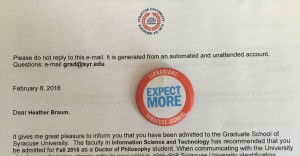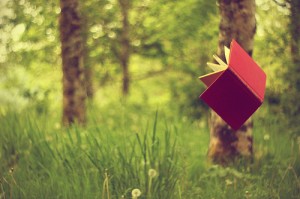“For everything there is a season, and a time for every matter under heaven” –Ecc. 3:1
I’ve been sitting on some big news of possible major life changes for the last several weeks, and it became real last Monday with an email notification. Today, I received the official, “sign and agree to this” letter, and it’s time to spill the beans on social media:
I’ve been accepted to the Ph.D. program in Information Science & Technology at Syracuse University for Fall 2016 admittance, which means I’m moving to New York in early August. I am incredibly sad to be leaving NEKLS and the Kansas library community, especially after spending the first nine years of my library career here.
But, the Kansas library community has inspired me to take this next step in my career. In fact, the work and research that I hope to be doing is FOR this very special and dear-to-my-heart library community. Although research paths do change, right now I am planning to focus my studies and research on learning how to show the impact of small and rural libraries and librarians upon their communities (did you know 80.5% of public libraries are considered small and rural?). I am already hoping the Kansas library community can factor largely into this research and outcomes.
There are many great faculty and students at Syracuse, including the MLS program director, Jill Hurst-Wahl, who kindly sent me the “Expect More” button last summer that I laid on top of my acceptance letter in the above photo. I’ve carried that button around for months as a reminder, to expect more of libraries and of myself. That button was a nice reminder last fall as I wrestled with the question of what was next in my career.
Many people have asked me, “Why Syracuse?”; I also had to address that question in my application. Syracuse is a great school with a great reputation (although, my college basketball allegiances won’t be swayed!) and the iSchool’s PhD program has a multi-disciplinary approach, which is attractive to me.
But the biggest answer to “Why Syracuse?” is because of Dr. R. David Lankes. His theory of new librarianship, “The mission of librarians is to improve society through facilitating knowledge creation in their communities” is an important frame of reference for the future of the library profession. I look forward to studying with him and other faculty at the iSchool and University.
My time in Kansas, for now, is coming to an end in six months. It’s going to be hard to leave family, friends, colleagues, and this very special library community. But I will be leaving to continue to work for you all, and, as much as I hate Wizard of Oz jokes, “There IS no place like home.”

